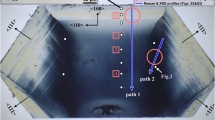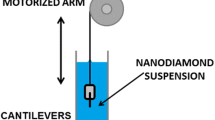Abstract
We report on the electrical and structural properties of boron-doped diamond tips commonly used for in-situ electromechanical testing during nanoindentation. The boron dopant environment, as evidenced by cathodoluminescence (CL) microscopy, revealed significantly different boron states within each tip. Characteristic emission bands of both electrically activated and nonelectrically activated boron centers were identified in all boron-doped tips. Surface CL mapping also revealed vastly different surface properties, confirming a high amount of nonelectrically activated boron clusters at the tip surface. Raman microspectroscopy analysis showed that structural characteristics at the atomic scale for boron-doped tips also differ significantly when compared to an undoped diamond tip. Furthermore, the active boron concentration, as inferred via the Raman analysis, varied greatly from tip-to-tip. It was found that tips (or tip areas) with low overall boron concentration have a higher number of electrically inactive boron, and thus non-Ohmic contacts were made when these tips contacted metallic substrates. Conversely, tips that have higher boron concentrations and a higher number of electrically active boron centers display Ohmic-like contacts. Our results demonstrate the necessity to understand and fully characterize the boron environments, boron concentrations, and atomic structure of the tips prior to performing in situ electromechanical experiments, particularly if quantitative electrical data are required.






Similar content being viewed by others
References
M.I. Eremets, V.V. Struzhkin, H-K. Mao, and R.J. Hemley: Superconductivity in boron. Science 293, 272 (2001).
J.M. Besson, E.H. Mokhtari, J. Gonzalez, and G. Weill: Electrical properties of semimetallic silicon III and semiconductive silicon IV at ambient pressure. Phys. Rev. Lett. 59, 473 (1987).
R. Nowak, D. Chrobak, S. Nagao, D. Vodnick, M. Berg, A. Tukiainen, and M. Pessa: An electric current spike linked to nanoscale plasticity. Nat. Nanotechnol. 4, 287 (2009).
J.E. Bradby, J.S. Williams, and M.V. Swain: In situ electrical characterization of phase transformations in Si during indentation. Phys. Rev. B 67, 085205 (2003).
S. Ruffell, J.E. Bradby, J.S. Williams, and O.L. Warren: An in situ electrical measurement technique via a conducting diamond tip for nanoindentation in silicon. J. Mater. Res. 22, 578 (2007).
A.B. Mann, D. van Heerden, J.B. Pethica, and T.P. Weihs: Size-dependent phase transformations during point loading of silicon. J. Mater. Res. 15, 1754 (2000).
S. Ruffell, K. Sears, A.P. Knights, J.E. Bradby, and J.S. Williams: Experimental evidence for semiconducting behavior of Si-XII. Phys. Rev. B 83, 075316 (2011).
L. Fang, C.L. Muhlstein, J.G. Collins, A.L. Romasco, and L.H. Friedman: Continuous electrical in situ contact area measurement during instrumented indentation. J. Mater. Res. 23, 2480 (2008).
N. Fujisawa, S. Ruffell, J.E. Bradby, J.S. Williams, B. Haberl, and O.L. Warren: Understanding pressure-induced phase-transformation behavior in silicon through in situ electrical probing under cyclic loading conditions. J. Appl. Phys. 105, 106111 (2009).
S. Ruffell, J.E. Bradby, N. Fujisawa, and J.S. Williams: Identification of nanoindentation-induced phase changes in silicon by in situ electrical characterization. J. Appl. Phys. 101, 083531 (2007).
M. Bhaskaran, S. Sriram, S. Ruffell, and A. Mitchell: Nanoscale characterization of energy generation from piezoelectric thin films. Adv. Funct. Mater. 21, 2251 (2011).
Hysitron: TI-950-TriboIndenter. http://www.hysitron.com/products/ti-series/ti-950-triboindenter.
S.V. Kalinin, B.J. Rodriguez, S. Jesse, E. Karapetian, B. Mirman, E.A. Eliseev, and A.N. Morozovska: Nanoscale electromechanics of ferroelectric and biological systems: A new dimension in scanning-probe microscopy. Annu. Rev. Mater. Res. 37, 189 (2007).
R. Holm: Electric Contacts; Theory and Applications (Springer, New York, 2000).
T. Tachibana, B.E. Williams, and J.T. Glass: Correlation of the electrical properties of metal contacts on diamond films with the chemical nature of the metal-diamond interface. i. gold contacts: A non-carbide-forming metal. Phys. Rev. B 45, 11968 (1992).
T. Tachibana, B.E. Williams, and J.T. Glass: Correlation of the electrical properties of metal contacts on diamond films with the chemical nature of the metal-diamond interface. ii. Titanium contacts: A carbide-forming metal. Phys. Rev. B 45, 11975 (1992).
R.J. Trew, J.B. Yan, and P.M. Mock: The potential of diamond and SiC electronic devices for microwave and millimeter-wave power applications. Proc. IEEE 79, 598 (1991).
K. Thonke: The boron acceptor in diamond. Semicond. Sci. Technol. 18, S20 (2003).
N. Tumilty, J. Welch, R. Lang, C. Wort, R. Balmer, and R.B. Jackman: An impedance spectroscopic investigation of the electrical properties of delta-doped diamond structures. J. Appl. Phys. 106, 103707 (2009).
N. Iwashita, M.V. Swain, J.S. Field, N. Ohta, and S. Bitoh: Elasto-plastic deformation of glass -like carbons heat-treated at different temperatures. Carbon 39, 1525 (2001).
P.K. Baumann and R.J. Nemanich: Electron affinity and Schottky barrier height of metal–diamond (100), (111), and (110) interfaces. J. Appl. Phys. 83, 2072 (1998).
A.T. Collins, A. Connor, C.H. Ly, A. Shareef, and P.M. Spear: High-temperature annealing of optical centers in type-i diamond. J. Appl. Phys. 97, 083517 (2005).
A.T. Collins and G.S. Woods: Cathodoluminescence from giant platelets, and of the 2.526 eV vibronic system, in type Ia diamonds. Philos. Mag. B 45, 385 (1982).
P.B. Klein, M.D. Crossfield, J.A. Freitas Jr., and A.T. Collins: Donor-acceptor pair recombination in synthetic type-iib semiconducting diamond. Phys. Rev. B 51, 9634 (1995).
L.H. Robins, L.P. Cook, E.N. Farabaugh, and A. Feldman: Cathodoluminescence of defects in diamond films and particles grown by hot-filament chemical-vapor deposition. Phys. Rev. B 39, 13367 (1989).
M. Kadri, D. Araujo, M. Wade, A. Deneuville, and E. Bustarret: Effect of oxygen on the cathodoluminescence signal from excitons, impurities and structural defects in homoepitaxial (100) diamond films. Diamond Relat. Mater. 14, 566 (2005).
L.H. Robins, E.N. Farabaugh, and A. Feldman: Cathodoluminescence spectroscopy of free and bound excitons in chemical-vapor-deposited diamond. Phys. Rev. B 48, 14167 (1993).
H. Sternschulte, J. Horseling, T. Albrecht, and K. Thonke: Characterization of doped and undoped CVD-diamond films by cathodoluminescence. Diamond Relat. Mater. 5, 585 (1996).
D. Takeuchi, H. Watanabe, S. Yamanaka, H. Okushi, H. Sawada, H. Ichinose, T. Sekiguchi, and K. Kajimura: Origin of band-A emission in diamond thin films. Phys. Rev. B 63, 245328 (2001).
H. Kawarada, H. Matsuyama, Y. Yokota, T. Sogi, A. Yamaguchi, and A. Hiraki: Excitonic recombination radiation in undoped and boron-doped chemical-vapor-deposited diamonds. Phys. Rev. B 47, 3633 (1993).
H. Kawarada, Y. Yokota, and A. Hiraki: Intrinsic and extrinsic recombination radiation from undoped and boron-doped diamonds formed by plasma chemical vapor deposition. Appl. Phys. Lett. 57, 1889 (1990).
R.J. Graham, T.D. Moustakas, and M.M. Disko: Cathodoluminescence imaging of defects and impurities in diamond films grown by chemical vapor deposition. J. Appl. Phys. 69, 3212 (1991).
S. Koizumi, K. Watanabe, M. Hasegawa, and H. Kanda: Ultraviolet emission from a diamond pn junction. Science 292, 1899 (2001).
S.C. Lawson, H. Kanda, H. Kiyota, T. Tsutsumi, and H. Kawarada: Cathodoluminescence from high-pressure synthetic and chemical-vapor-deposited diamond. J. Appl. Phys. 77, 1729 (1995).
P. Muret and M. Wade: Acceptor compensation by dislocations related defects in boron doped homoepitaxial diamond films from cathodoluminescence and Schottky diodes current-voltage characteristics. Phys. Status Solidi A 203, 3142 (2006).
C. Baron, A. Deneuville, M. Wade, F. Jomard, and J. Chevallier: Cathodoluminescence measurements on heavily boron doped homoepitaxial diamond films and their interfaces with their Ib substrates. Phys. Status Solidi A 203, 544 (2006).
H. Kawarada, Y. Yokota, Y. Mori, K. Nishimura, and A. Hiraki: Cathodoluminescence and electroluminescence of undoped and boron-doped diamond formed by plasma chemical vapor deposition. J. Appl. Phys. 67, 983 (1990).
P.J. Dean: Bound excitons and donor-acceptor pairs in natural and synthetic diamond. Phys. Rev. 139, A588 (1965).
J. Ruan, K. Kobashi, and W.J. Choyke: On the “band-A” emission and boron related luminescence in diamond. Appl. Phys. Lett. 60, 3138 (1992).
D.S. Knight and W.B. White: Characterization of diamond films by Raman spectroscopy. J. Mater. Res. 4, 385 (1989).
K. Nishimura, K. Das, and J.T. Glass: Material and electrical characterization of polycrystalline boron-doped diamond films grown by microwave plasma chemical vapor deposition. J. Appl. Phys. 69, 3142 (1991).
M. Mermoux, F. Jomard, C. Tavars, F. Omns, and E. Bustarret: Raman characterization of boron-doped 111 homoepitaxial diamond layers. Diamond Relat. Mater. 15, 572 (2006).
M. Mermoux, B. Marcus, G.M. Swain, and J.E. Butler: A confocal Raman imaging study of an optically transparent boron-doped diamond electrode. J. Phys. Chem. B 106, 10816 (2002).
S. Szunerits, M. Mermoux, A. Crisci, B. Marcus, P. Bouvier, D. Delabouglise, J.P. Petit, S. Janel, R. Boukherroub, and L. Tay: Raman imaging and Kelvin probe microscopy for the examination of the heterogeneity of doping in polycrystalline boron-doped diamond electrodes. J. Phys. Chem. B 110, 23888 (2006).
E. Bourgeois, E. Bustarret, P. Achatz, F. Omnes, and X. Blase: Impurity dimers in superconducting B-doped diamond: Experiment and first-principles calculations. Phys. Rev. B 74, 094509 (2006).
J.P. Goss and P.R. Briddon: Theory of boron aggregates in diamond: First-principles calculations. Phys. Rev. B 73, 085204 (2006).
J.W. Ager III, W. Walukiewicz, M. Mc Cluskey, M.A. Plano, and M.I. Landstrass: Fano interference of the Raman phonon in heavily boron-doped diamond films grown by chemical vapor deposition. Appl. Phys. Lett. 66, 616 (1995).
P. Gonon, E. Gheeraert, A. Deneuville, F. Fontaine, L. Abello, and G. Lucazeau: Characterization of heavily B-doped polycrystalline diamond films using Raman spectroscopy and electron spin resonance. J. Appl. Phys. 78, 7059 (1995).
F. Pruvost and A. Deneuville: Analysis of the Fano in diamond. Diamond Relat. Mater. 10, 531 (2001).
Acknowledgments
This research was supported by an Australian Research Council Linkage project. JB is the recipient of an Australian Research Council QEII Fellowship.
Author information
Authors and Affiliations
Corresponding author
Rights and permissions
About this article
Cite this article
Sprouster, D.J., Ruffell, S., Bradby, J.E. et al. Structural characterization of B-doped diamond nanoindentation tips. Journal of Materials Research 26, 3051–3057 (2011). https://doi.org/10.1557/jmr.2011.377
Received:
Accepted:
Published:
Issue Date:
DOI: https://doi.org/10.1557/jmr.2011.377




